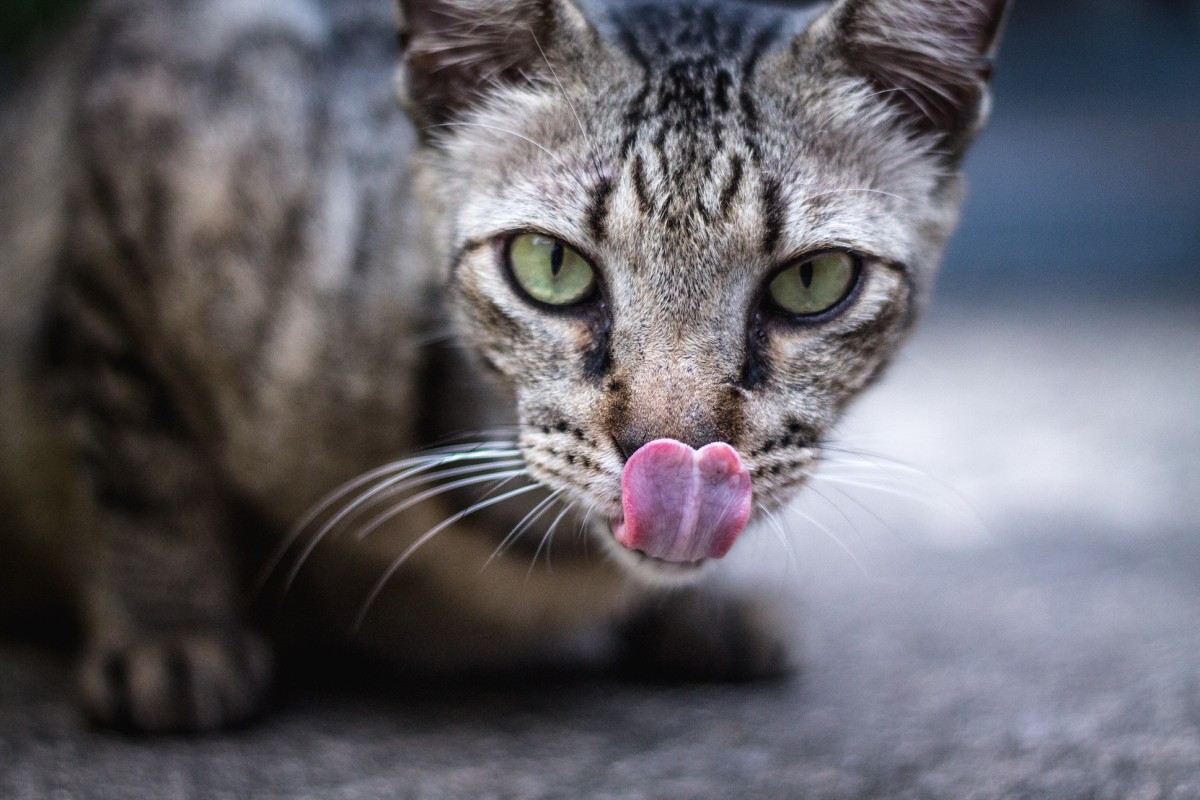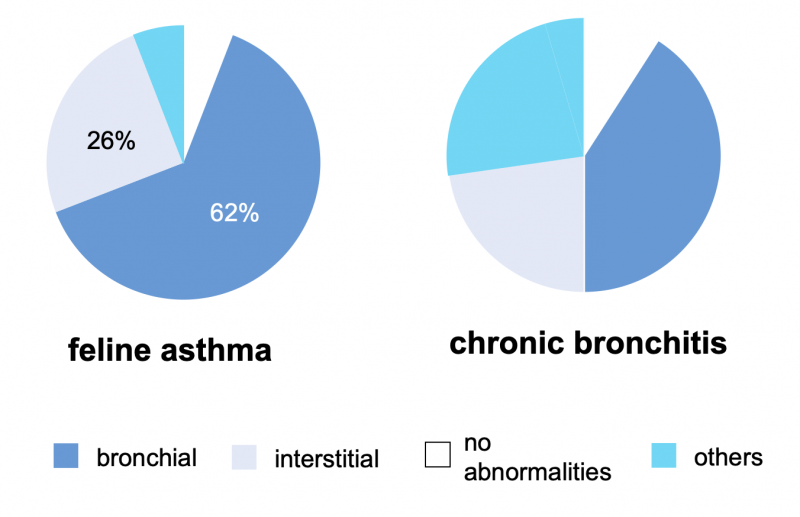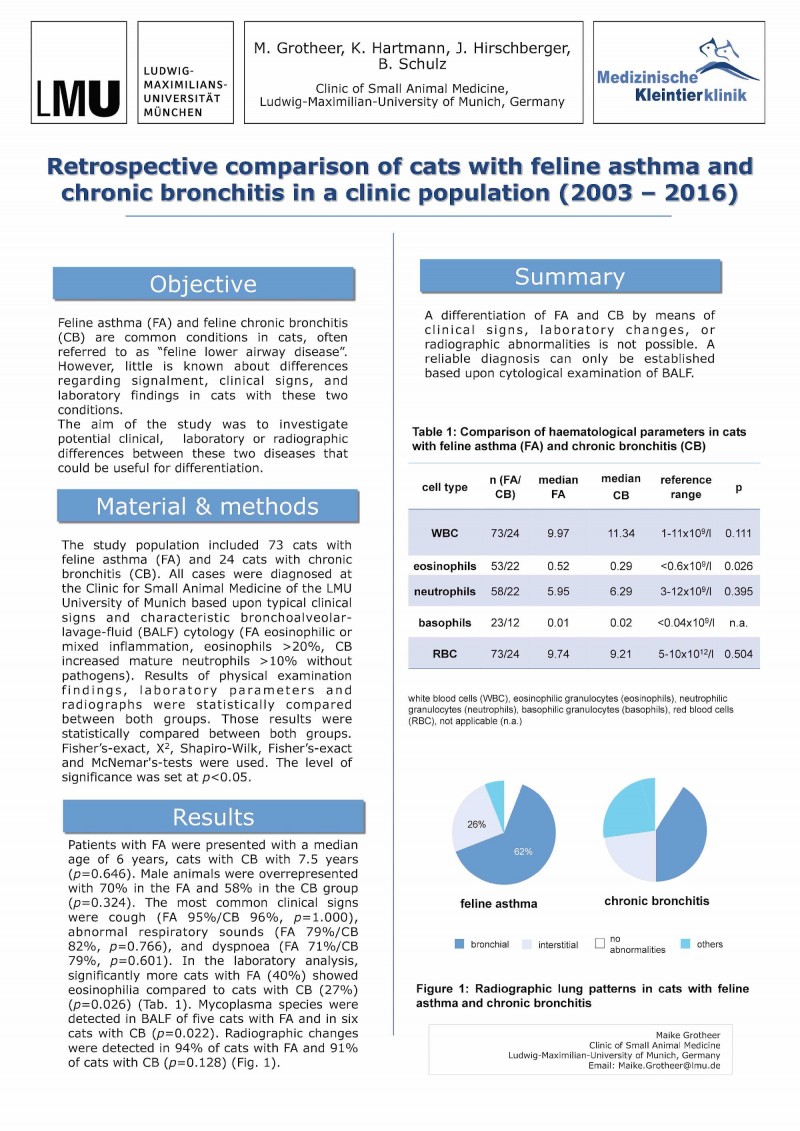
Retrospective comparison of cats with feline asthma and chronic bronchitis in a clinic population (2003 – 2016)
MedUP rookie
Maike Grotheer, Katrin Hartmann, Bianka Schulz, Johannes Hirschberger
Poster presentation on ESVIM 2018, Rotterdam (Best poster abstract presentation)
Objective
Feline asthma (FA) and feline chronic bronchitis (CB) are common conditions in cats, often referred to as “feline lower airway disease”. However, little is known about differences regarding signalment, clinical signs, and laboratory findings in cats with these two conditions.
The aim of the study was to investigate potential clinical, laboratory or radiographic differences between these two diseases that could be useful for differentiation.
Material and Methods
The study population included 73 cats with feline asthma (FA) and 24 cats with chronic bronchitis (CB). All cases were diagnosed at the Clinic for Small Animal Medicine of the LMU University of Munich based upon typical clinical signs and characteristic bronchoalveolar-lavage-fluid (BALF) cytology (FA eosinophilic or mixed inflammation, eosinophils >20%, CB increased mature neutrophils >10% without pathogens). Results of physical examination findings, laboratory parameters and radiographs were statistically compared between both groups. Those results were statistically compared between both groups. Fisher’s-exact, Χ2, Shapiro-Wilk, Fisher’s-exact and McNemar's-tests were used. The level of significance was set at p<0.05.
Results
Patients with FA were presented with a median age of 6 years, cats with CB with 7.5 years (p=0.646). Male animals were overrepresented with 70% in the FA and 58% in the CB group (p=0.324). The most common clinical signs were cough (FA 95%/CB 96%, p=1.000), abnormal respiratory sounds (FA 79%/CB 82%, p=0.766), and dyspnoea (FA 71%/CB 79%, p=0.601). In the laboratory analysis, significantly more cats with FA (40%) showed eosinophilia compared to cats with CB (27%) (p=0.026) (Tab. 1). Mycoplasma species were detected in BALF of five cats with FA and in six cats with CB (p=0.022). Radiographic changes were detected in 94% of cats with FA and 91% of cats with CB (p=0.128) (Fig. 1).
Table 1: Comparison of haematological parameters in cats with feline asthma (FA) and chronic bronchitis (CB)
| cell type | n (FA/CB) | medianFA | median CB | reference range* | p |
| WBC | 73/24 | 9.97 | 11.34 | 1-11x10 *9/l | 111 |
| eosinophils | 53/22 | 0.52 | 0.29 | <0.6x10 *9/l | 26 |
| neutrophils | 58/22 | 5.95 | 6.29 | 3-12x10 *9/l | 395 |
| basophils | 23/12 | 0.01 | 0.02 | <0.04x10 *9/l | n.a. |
| RBC | 73/24 | 9.74 | 9.21 | 5-10x10 *12/l | 504 |
white blood cells (WBC), eosinophilic granulocytes (eosinophils), neutrophilic granulocytes (neutrophils), basophilic granulocytes (basophils), red blood cells (RBC), not applicable (n.a.)
______________
*
<0.6x109/l
3-12x109/l
<0.04x109/l
5-10x1012/l

Figure 1: Radiographic lung patterns in cats with feline asthma and chronic bronchitis
Summary
A differentiation of FA and CB by means of clinical signs, laboratory changes, or radiographic abnormalities is not possible. A reliable diagnosis can only be established based upon cytological examination of BALF.
Original Poster

Please also see the corresponding comprehensive article in PubMed:
Grotheer M, Hirschberger J, Hartmann K, Castelletti N, Schulz B. Comparison of signalment, clinical, laboratory and radiographic parameters in cats with feline asthma and chronic bronchitis. J Feline Med Surg. 2019 Sep 4: 1098612X19872428 doi: 10.1177/1098612X19872428
Image soucre
Teaser image by © shubhankar-sharma, unsplash.